Whiting-Turner Contracting Bundle
How did Whiting-Turner Build Its Legacy?
In a world defined by towering skyscrapers and intricate infrastructure, understanding the Whiting-Turner Contracting SWOT Analysis is crucial. Imagine a construction company that has not only survived but thrived for over a century. This is the story of Whiting-Turner Contracting Company, a beacon of excellence in the construction industry. Their history is a compelling narrative of innovation, resilience, and unwavering commitment to quality.
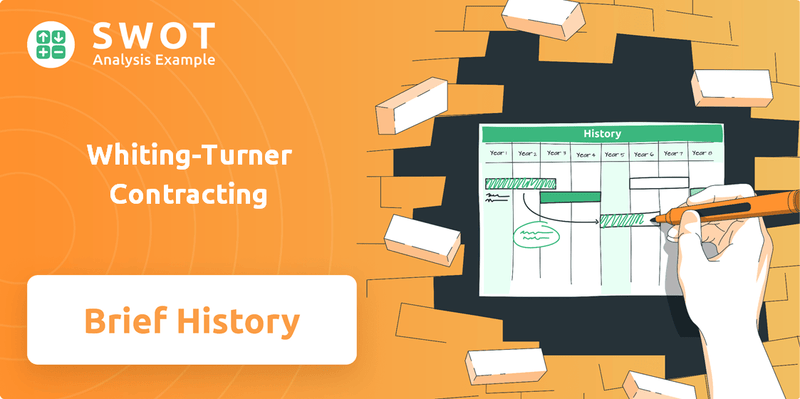
Founded in 1909 in Baltimore, this contracting firm has a rich history, evolving from its early projects to become a national leader. This brief history of Whiting-Turner explores the key milestones, from its founding date to its current status. Discover how Whiting-Turner's adaptability and client-centric approach have solidified its place among the top construction companies.
What is the Whiting-Turner Contracting Founding Story?
The story of the Whiting-Turner Contracting Company began on July 1, 1909. It was founded by Gustave W.C. Whiting and LeRoy F. Turner. This marked the start of a significant player in the construction industry.
The founders' backgrounds were key to their early success. G.W.C. Whiting, a civil engineer, brought experience from projects like the Baltimore & Ohio Railroad. LeRoy F. Turner, a skilled builder, offered practical construction knowledge. They saw an opportunity in the growing industrial and commercial sectors.
Their initial focus was on general contracting. This included industrial facilities, commercial buildings, and public works. The company's name reflected the founders' commitment. Initial funding likely came from personal investments and early project financing. Building a reputation and securing contracts were early challenges. The early 20th century's industrial growth set the stage for their success.
The company was founded in 1909 by Gustave W.C. Whiting and LeRoy F. Turner, who brought engineering and building expertise. They aimed to provide high-quality contracting services in a time of industrial and commercial expansion.
- Founding Date: July 1, 1909
- Founders: Gustave W.C. Whiting and LeRoy F. Turner
- Initial Focus: General contracting for industrial, commercial, and public projects
- Early Challenges: Establishing a reputation and securing initial contracts
Whiting-Turner Contracting SWOT Analysis
- Complete SWOT Breakdown
- Fully Customizable
- Editable in Excel & Word
- Professional Formatting
- Investor-Ready Format
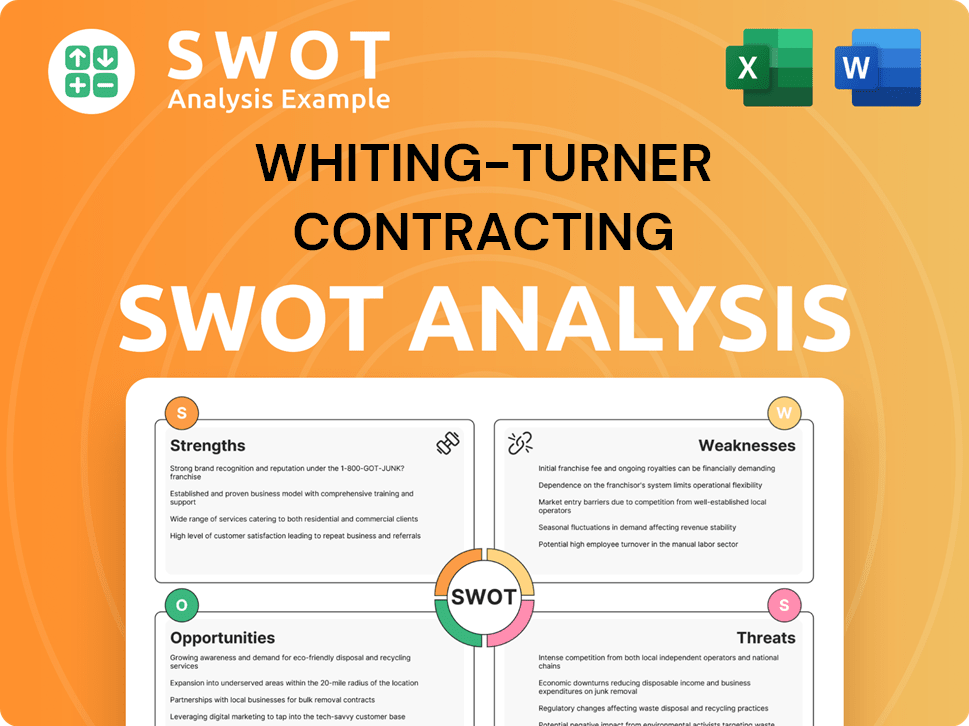
What Drove the Early Growth of Whiting-Turner Contracting?
The early growth of the Whiting-Turner Contracting Company, a prominent contracting firm, was characterized by a focus on building a strong foundation. Initially, the company secured various industrial and commercial projects within the Baltimore construction market. This early phase emphasized quality and timely project completion, which helped establish a solid reputation. The company's expansion included increasing its workforce and project management capabilities.
Whiting-Turner's initial projects were primarily in the Baltimore area, serving manufacturers and local businesses. These early contracts were crucial in building the company's portfolio. The focus was on delivering projects on time and within budget, which helped build a reputation for reliability. This early success set the stage for future expansion.
The company strategically extended its reach beyond Baltimore, taking on projects in neighboring states. This organic expansion was driven by repeat business and referrals. The ability to successfully deliver complex construction projects across different sectors was key. This gradual expansion helped solidify Whiting-Turner's position in the construction industry.
Whiting-Turner diversified its project types to include healthcare, education, retail, and government facilities. This diversification was critical for navigating economic fluctuations and maintaining growth. The company's ability to adapt to evolving industry demands was essential. The company's approach to Growth Strategy of Whiting-Turner Contracting played a key role in its expansion.
Leadership transitions over time maintained the company's core values and strategic direction, fostering continuity. The company's commitment to delivering on its promises helped solidify its position. By consistently adapting to industry changes, Whiting-Turner laid the groundwork for its significant presence in the national construction market. The company's focus on internal development and expanding capabilities was a key factor.
Whiting-Turner Contracting PESTLE Analysis
- Covers All 6 PESTLE Categories
- No Research Needed – Save Hours of Work
- Built by Experts, Trusted by Consultants
- Instant Download, Ready to Use
- 100% Editable, Fully Customizable
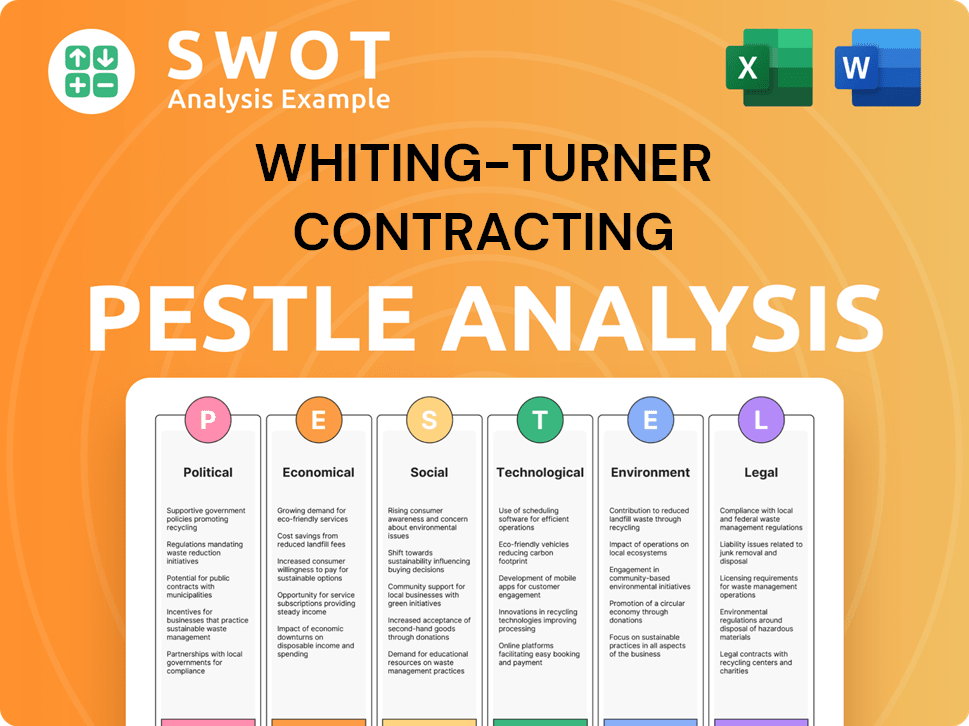
What are the key Milestones in Whiting-Turner Contracting history?
The Whiting-Turner Contracting Company has a rich history marked by significant achievements and a commitment to evolving with the construction industry. This construction company history reflects its growth from a small firm to a national leader, showcasing its adaptability and dedication to excellence. The Whiting-Turner history is a testament to its enduring presence and impact on the built environment.
| Year | Milestone |
|---|---|
| 1909 | Founded in Baltimore, Maryland, by G.W.C. Whiting and LeBaron Turner, marking the beginning of the Whiting-Turner Contracting Company. |
| Early 20th Century | Undertook various projects in the Baltimore area, establishing a reputation for quality and reliability. |
| Mid-20th Century | Expanded its operations and scope, undertaking larger and more complex projects across different sectors. |
| World War II | Contributed to the war effort by constructing essential facilities for the military. |
| Late 20th Century | Grew into a national contracting firm, with offices and projects throughout the United States. |
| 21st Century | Continued to embrace technological advancements and sustainable practices, solidifying its position as an industry leader. |
Throughout its history, Whiting-Turner has consistently adopted innovative construction technologies. This includes the implementation of Building Information Modeling (BIM) and lean construction principles to improve project efficiency.
Offering comprehensive preconstruction services, including detailed cost estimating, scheduling, and constructability reviews, to optimize project planning and execution. This approach helps in mitigating risks and ensuring projects stay within budget and on schedule.
Utilizing BIM for creating detailed 3D models of construction projects, which enhances coordination among different teams, reduces errors, and improves overall project outcomes. This technology allows for better visualization and planning.
Employing lean construction methodologies to minimize waste, streamline processes, and maximize value for clients. This includes techniques like just-in-time delivery and collaborative planning to improve efficiency.
Integrating sustainable building practices and technologies to reduce environmental impact and promote energy efficiency. This includes using green materials and implementing strategies for waste reduction and recycling.
Using VDC to integrate design and construction processes, improving project outcomes through enhanced collaboration and data-driven decision-making. This approach helps in identifying and resolving potential issues early in the process.
Adopting modular construction techniques to improve project timelines and reduce costs. This involves off-site fabrication of building components, which are then assembled on-site, leading to faster construction times and reduced labor costs.
Like any major player in the construction industry, Whiting-Turner has faced challenges such as economic downturns and material price fluctuations. The company has also had to manage complex projects with unforeseen site conditions or design changes, which requires robust project management.
Navigating economic recessions and market fluctuations by maintaining financial discipline and diversifying its project portfolio. This approach helps in spreading risk and ensuring financial stability during uncertain times.
Managing the volatility of material costs through strategic procurement and strong supplier relationships. This includes using advanced forecasting tools and negotiating favorable terms to mitigate the impact of price increases.
Addressing labor shortages by investing in workforce development programs and fostering a positive work environment. This includes offering competitive wages and benefits, as well as providing training and career advancement opportunities.
Managing complex projects with unforeseen site conditions or design changes through robust project management and proactive problem-solving. This involves meticulous planning, detailed risk assessments, and close collaboration with clients and subcontractors.
Facing competition from other large national and regional contractors by continuously innovating and improving efficiency. This includes investing in new technologies, refining project management processes, and focusing on client satisfaction.
Adapting to new building codes and regulations by staying informed and adjusting project strategies accordingly. This includes ensuring compliance with all relevant standards and incorporating sustainable construction practices.
Whiting-Turner Contracting Business Model Canvas
- Complete 9-Block Business Model Canvas
- Effortlessly Communicate Your Business Strategy
- Investor-Ready BMC Format
- 100% Editable and Customizable
- Clear and Structured Layout
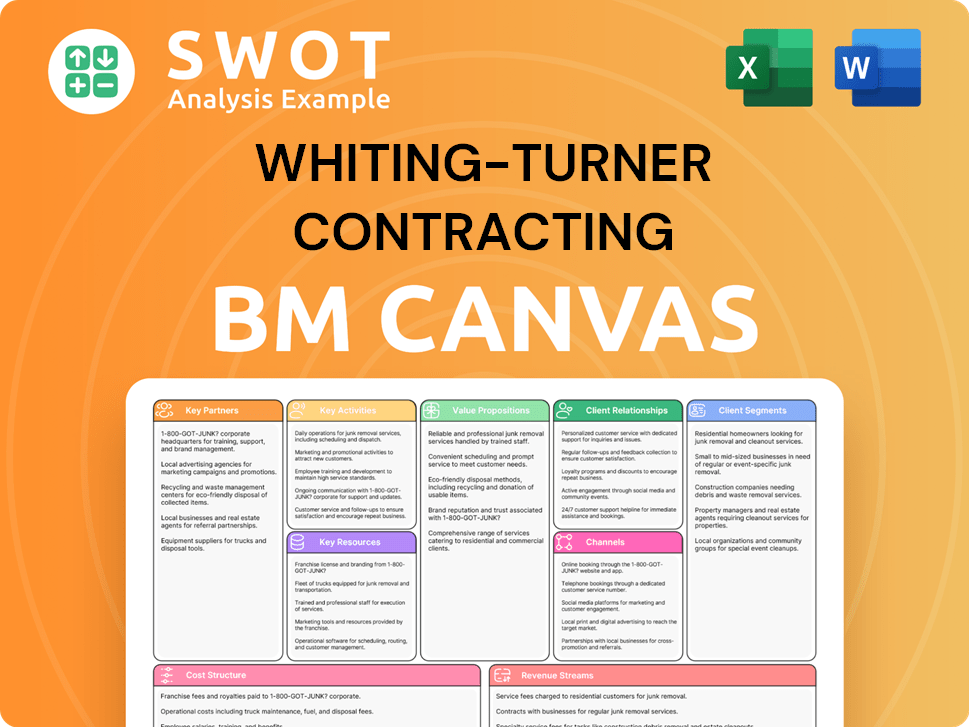
What is the Timeline of Key Events for Whiting-Turner Contracting?
The Whiting-Turner Contracting Company has a rich history, marked by significant projects and a consistent presence in the construction industry. The company's evolution reflects the broader trends in construction, adapting to technological advancements and changing market demands. This timeline highlights key milestones in the Whiting-Turner history.
| Year | Key Event |
|---|---|
| 1909 | G.W.C. Whiting and LeBaron Turner establish the company in Baltimore, Maryland. |
| Early 20th Century | The company undertakes various construction projects, primarily in the Baltimore area, building a reputation for quality and reliability. |
| World War II | Whiting-Turner plays a role in wartime construction efforts, contributing to the national infrastructure. |
| Post-War Era | The company expands its operations, taking on larger and more complex projects across different sectors. |
| Late 20th Century | Whiting-Turner continues to grow, embracing new technologies and project management techniques to improve efficiency and project outcomes. |
| 2024-2025 | Whiting-Turner remains a major player in the construction industry, involved in diverse projects and maintaining a strong presence in the market. |
Whiting-Turner is expected to continue its expansion into new markets and project types. This strategy involves diversification to reduce risk and capitalize on emerging opportunities, such as sustainable building and infrastructure projects. The company's ability to adapt to changing market dynamics will be key to its future growth.
The firm will likely increase its adoption of advanced technologies, including Building Information Modeling (BIM), artificial intelligence, and automation, to improve project efficiency, reduce costs, and enhance safety. Investment in these technologies will be critical for maintaining a competitive edge in the construction industry. The company is expected to focus on data analytics to improve project outcomes.
Sustainability is becoming increasingly important in construction. Whiting-Turner is likely to prioritize sustainable building practices, seeking LEED certifications, and integrating green technologies into its projects. This focus will align with growing environmental concerns and regulations, attracting clients who prioritize sustainability. The company will invest in eco-friendly materials and construction methods.
Building strategic partnerships with other firms, technology providers, and suppliers will be important for Whiting-Turner. These alliances can provide access to specialized expertise, new markets, and innovative solutions. Collaborations can also help the company manage risks and improve its overall competitiveness. The company may seek joint ventures to expand its project portfolio.
Whiting-Turner Contracting Porter's Five Forces Analysis
- Covers All 5 Competitive Forces in Detail
- Structured for Consultants, Students, and Founders
- 100% Editable in Microsoft Word & Excel
- Instant Digital Download – Use Immediately
- Compatible with Mac & PC – Fully Unlocked
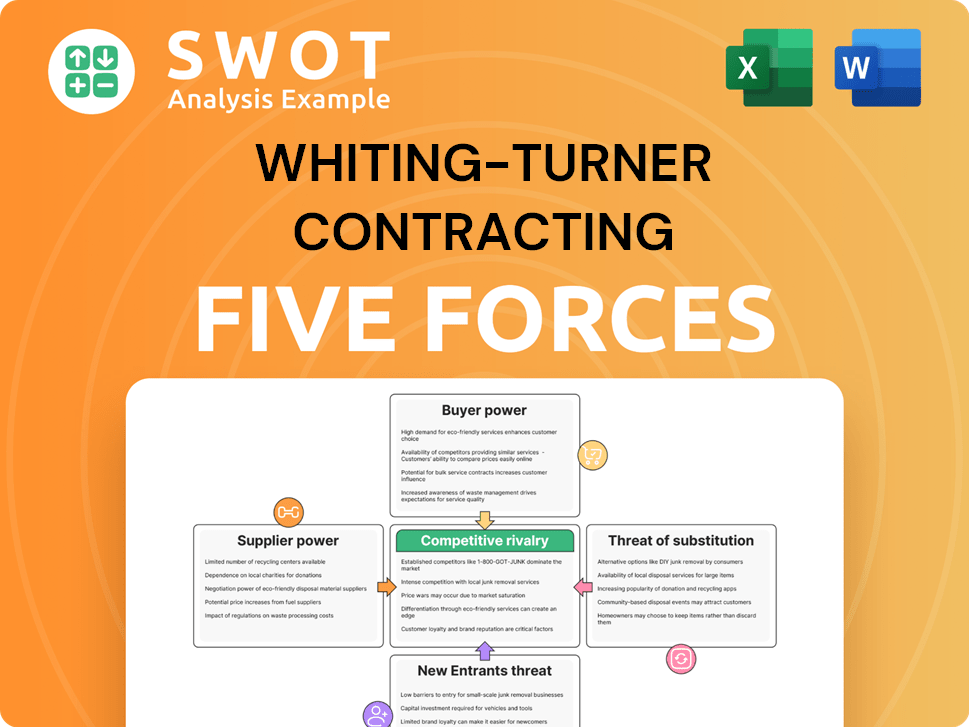
Related Blogs
- What is Competitive Landscape of Whiting-Turner Contracting Company?
- What is Growth Strategy and Future Prospects of Whiting-Turner Contracting Company?
- How Does Whiting-Turner Contracting Company Work?
- What is Sales and Marketing Strategy of Whiting-Turner Contracting Company?
- What is Brief History of Whiting-Turner Contracting Company?
- Who Owns Whiting-Turner Contracting Company?
- What is Customer Demographics and Target Market of Whiting-Turner Contracting Company?
Disclaimer
All information, articles, and product details provided on this website are for general informational and educational purposes only. We do not claim any ownership over, nor do we intend to infringe upon, any trademarks, copyrights, logos, brand names, or other intellectual property mentioned or depicted on this site. Such intellectual property remains the property of its respective owners, and any references here are made solely for identification or informational purposes, without implying any affiliation, endorsement, or partnership.
We make no representations or warranties, express or implied, regarding the accuracy, completeness, or suitability of any content or products presented. Nothing on this website should be construed as legal, tax, investment, financial, medical, or other professional advice. In addition, no part of this site—including articles or product references—constitutes a solicitation, recommendation, endorsement, advertisement, or offer to buy or sell any securities, franchises, or other financial instruments, particularly in jurisdictions where such activity would be unlawful.
All content is of a general nature and may not address the specific circumstances of any individual or entity. It is not a substitute for professional advice or services. Any actions you take based on the information provided here are strictly at your own risk. You accept full responsibility for any decisions or outcomes arising from your use of this website and agree to release us from any liability in connection with your use of, or reliance upon, the content or products found herein.